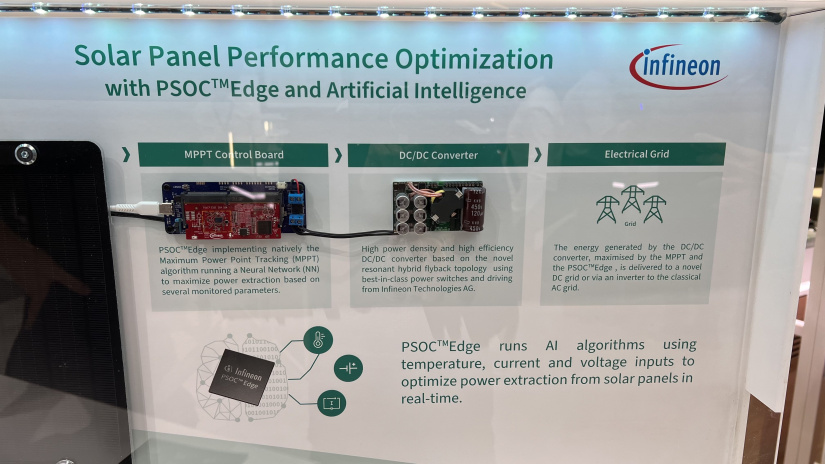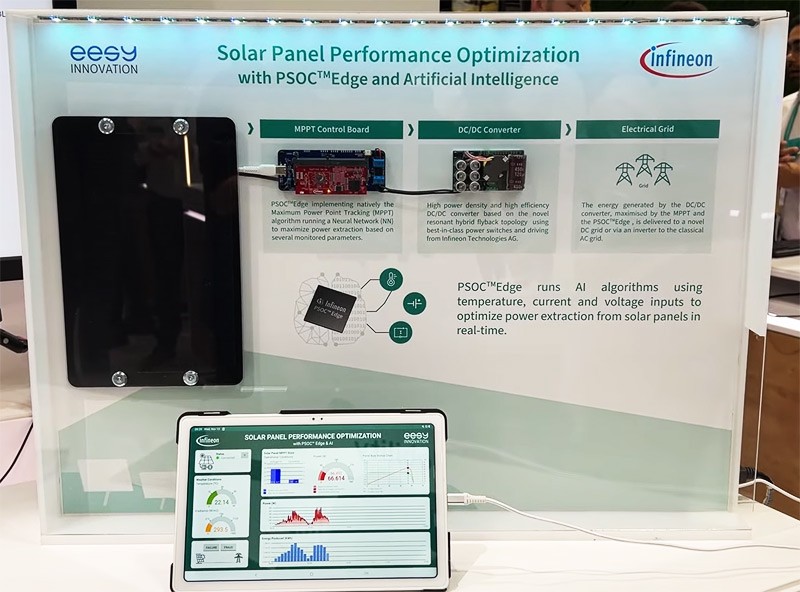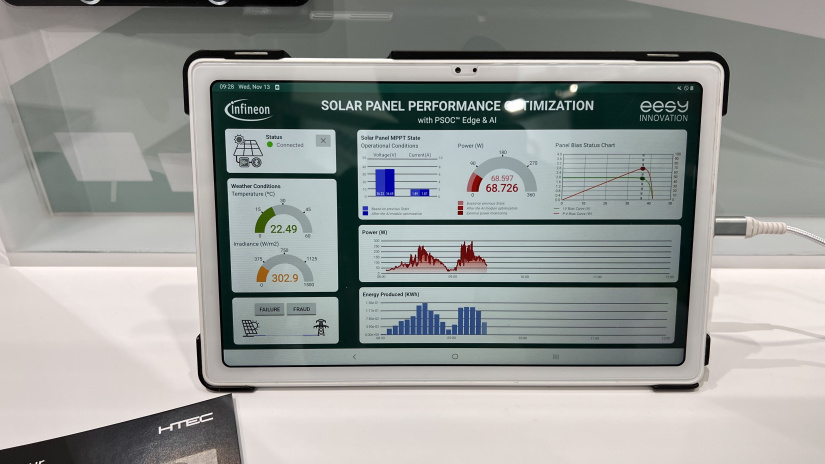Optimizing Solar Power with Infineon’s PSoC™ Edge AI MCUs
Infineon’s PSOC™ Edge series MCUs bring advanced AI capabilities to the forefront of edge applications, addressing the unique demands of renewable energy optimization. Leveraging low-power, high-performance architecture, these microcontrollers are purpose-built to handle real-time processing for edge AI tasks, particularly in solar energy systems. At Electronica 2024 in Munich, Infineon showcased their latest advancements in this area, partnering with eesy-innovation GmbH, which was recently acquired by HTEC, to demonstrate how AI can enhance solar power efficiency through predictive power optimization
What is Infineon’s PSOC™ Edge Series?
Infineon’s PSOC™ Edge series is a range of microcontrollers specifically designed for AI at the edge, combining high-performance Arm® Cortex® cores with Infineon’s ultra-low-power NNLite neural network accelerator. This architecture enables efficient, real-time processing, making these MCUs ideal for applications that require constant, low-latency performance, such as IoT, smart home devices, wearables, and renewable energy systems.

The series supports “always-on” sensing and response, allowing edge devices to operate continuously while keeping power consumption low. This capability is crucial for energy-sensitive applications, where maximizing efficiency without sacrificing processing speed is essential. With the PSOC™ Edge, engineers can implement advanced AI functions with confidence in both performance and energy efficiency.
Whether it’s optimizing solar energy, enhancing security, or managing smart home devices, Infineon’s PSOC™ Edge microcontrollers are engineered to meet the growing demands of edge AI applications.
Optimizing Solar Power with Infineon’s Edge AI Technology
One of the standout applications for Infineon’s PSOC™ Edge series is in optimizing solar power systems, demonstrated at electronica 2024 through a collaboration with HTech. In this setup, the PSOC™ Edge MCU uses AI to predict the optimal power output from solar panels, streamlining the conversion process to maximize efficiency.

Traditionally, solar power optimization relied on maximum power point tracking (MPPT), a method that involves multiple iterative calculations to find the ideal power output. While effective, this approach can waste energy during the time spent in calculation cycles. By contrast, Infineon’s PSOC™ Edge MCU integrates a neural network capable of determining the optimal power point in a single iteration, achieving over 99% accuracy in real-time.
This predictive approach not only improves efficiency but also ensures that more energy is captured and utilized from the solar panel. With AI-driven optimization powered by Infineon’s technology, solar setups can operate with higher precision and significantly reduced energy loss, supporting sustainable energy initiatives.
Achieving High Efficiency with Minimal Power Usage
Infineon’s PSOC™ Edge MCUs offer exceptional efficiency gains by reducing the time and power required for AI computations. In comparison to traditional Cortex-based platforms, which may take up to seven milliseconds to complete similar tasks, the PSOC™ Edge series can process predictions in just 0.3 milliseconds—over 20 times faster. This drastic reduction in latency allows energy-sensitive applications like solar optimization to maximize energy usage without sacrificing processing accuracy.

The speed and efficiency of the PSOC™ Edge MCUs are especially beneficial for renewable energy solutions, where minimizing power consumption while maximizing output is crucial. By harnessing AI to optimize power output in real-time, Infineon’s technology enables systems to achieve a balanced, high-performance operation that aligns with green energy goals.
For engineers working with energy-efficient AI applications, the PSOC™ Edge series provides a reliable solution that combines processing power with low-energy consumption, making it a leading choice in sustainable technology design.
Beyond Solar: Expanding AI Capabilities with PSOC™ Edge
While Infineon’s PSOC™ Edge series shines in solar power optimization, its versatility extends to a wide range of AI applications. Built with support for complex tasks like image recognition and object detection, these microcontrollers can handle demanding workloads across various fields, including security systems, smart home devices, and wearable technology.
The PSOC™ Edge MCUs are equipped to run larger neural networks, such as the YOLO model for target detection, enabling applications that require high-performance AI processing on-device. Despite their robust capabilities, these MCUs maintain low latency and minimal power consumption, making them suitable for diverse AI-driven applications without compromising energy efficiency.
Infineon’s PSOC™ Edge provides engineers with a powerful and adaptable platform for creating intelligent, responsive devices that can operate independently at the edge, allowing for efficient deployment across industries.
Enhanced Development with ModusToolbox™ and DEEPCRAFT™
To support developers in implementing AI solutions at the edge, Infineon offers the ModusToolbox™ software suite alongside the DEEPCRAFT™ AI/ML support platform. ModusToolbox™ provides a range of development tools and software libraries, streamlining the process of programming, testing, and deploying applications on the PSOC™ Edge series.
With DEEPCRAFT™, developers gain access to dedicated AI and machine learning resources that simplify the integration of neural networks and other AI models. This suite accelerates development cycles, allowing engineers to focus on optimizing their designs for intelligent edge applications. Together, ModusToolbox™ and DEEPCRAFT™ enable engineers to bring sophisticated AI functions to market faster and with greater ease.
For those building responsive, low-power edge devices, these tools offer a comprehensive development environment tailored to Infineon’s PSOC™ Edge, enhancing both the efficiency and performance of their AI solutions.
To learn more about Infineon’s PSOC™ Edge series and explore how it can enhance your AI-driven designs, visit the Infineon PSOC™ Edge product page.














































Leave your feedback...